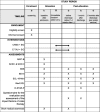Collaborative Assessment and Management of Suicidality (CAMS) compared to enhanced treatment as usual (E-TAU) for suicidal patients in an inpatient setting: study protocol for a randomized controlled trial
- PMID: 32321477
- PMCID: PMC7178967
- DOI: 10.1186/s12888-020-02589-x
Collaborative Assessment and Management of Suicidality (CAMS) compared to enhanced treatment as usual (E-TAU) for suicidal patients in an inpatient setting: study protocol for a randomized controlled trial
Abstract
Background: The Collaborative Assessment and Management of Suicidality (CAMS) is a therapeutic framework that has been shown to reduce suicidal ideation and overall symptom distress. CAMS has not been previously evaluated in a standard acute inpatient mental health care setting with only short treatment times for suicidal patients. In this randomized controlled trial (RCT) we are investigating whether CAMS is more effective than Enhanced-Treatment as Usual (E-TAU) in reducing suicidal thoughts as primary outcome variable. We are also investigating depressive symptoms, general symptom relief, and the quality of the therapeutic alliance as secondary outcomes.
Methods/design: This RCT is designed as a single-center, two-armed, parallel group observer-blinded clinical effectiveness investigation. We are recruiting and randomizing 60 participants with different diagnoses, who are admitted as inpatients because of acute suicidal thoughts or behaviors into the Clinic for Psychiatry and Psychotherapy, Ev. Hospital Bethel in Bielefeld, Germany. The duration of treatment will vary depending on patients' needs and clinical assessments ranging between 10 and 40 days. Patients are assessed four times, at admission, discharge, 1 month, and 5 months post-discharge. The primary outcome measure is the Beck Scale for Suicide Ideation. Other outcome measures are administered as assessment timepoints including severity of psychiatric symptoms, depression, reasons for living, and therapeutic relationship.
Discussion: This effectiveness study is being conducted on an acute ward in a psychiatric clinic where patients have multiple problems and diagnoses. Treatment is somewhat limited, and therapists have a large caseloads. The results of this study can thus be generalizable to a typical inpatient psychiatric hospital settings.
Trial registration: This clinical trial has been retrospectively registered with the German Clinical Trials Register; registration code/ DRKS-ID: DRKS00013727 (on January 12, 2018). In addition, the study was also registered with the International Clinical Trials Registry Platform of the World Health Organization (identical registration code). Registry Name: "Evaluation von CAMS versus TAU bei suizidalen Patienten - Ein stationärer RCT".
Keywords: CAMS; Collaborative approach; Randomized controlled trial; Suicidal patients; Suicidality; Suicide prevention; Treatment.
Conflict of interest statement
The authors declare that they have no competing interests. Dr. Jobes receives grant support from the National Institute of Mental Health (NIMH) and the American Foundation for Suicide Prevention in the United States. He receives book royalties from Guilford Press and American Psychological Association Publications. He is a founder and co-owner of CAMS-care LLC, a training and consultation company.
Figures
References
-
- Federal Statistical Office for Suicide Prevention, Germany, 2016. Available from https://www.destatis.de/DE/Themen/Gesellschaft-Umwelt/Gesundheit/Todesur....
-
- Kardels B, Kinn M. In: Akute psychiatrische Notfälle. Ein Leitfaden für den Notarzt und Rettungsdienst. Pajonk F-GB, editor. Stuttgart: Georg Thieme Verlag KG; 2008.
-
- Clark, D. C., Fawcett, J. Review of empirical risk factors for evaluation of the suicidal patient. In: B. Bongar (Ed.), Suicide. Guidelines for assessment, management, and treatment. New York: Oxford University Press, 1992. p.16–48.
Publication types
MeSH terms
Associated data
LinkOut - more resources
Full Text Sources
Medical




